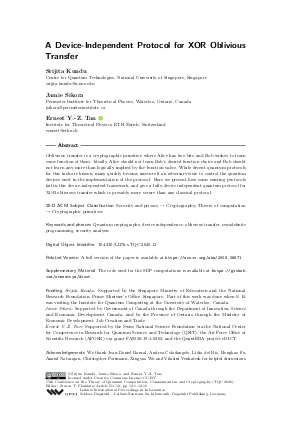@InProceedings{kundu_et_al:LIPIcs.TQC.2020.12,
author = {Kundu, Srijita and Sikora, Jamie and Tan, Ernest Y.-Z.},
title = {{A Device-Independent Protocol for XOR Oblivious Transfer}},
booktitle = {15th Conference on the Theory of Quantum Computation, Communication and Cryptography (TQC 2020)},
pages = {12:1--12:15},
series = {Leibniz International Proceedings in Informatics (LIPIcs)},
ISBN = {978-3-95977-146-7},
ISSN = {1868-8969},
year = {2020},
volume = {158},
editor = {Flammia, Steven T.},
publisher = {Schloss Dagstuhl -- Leibniz-Zentrum f{\"u}r Informatik},
address = {Dagstuhl, Germany},
URL = {https://drops.dagstuhl.de/entities/document/10.4230/LIPIcs.TQC.2020.12},
URN = {urn:nbn:de:0030-drops-127579},
doi = {10.4230/LIPIcs.TQC.2020.12},
annote = {Keywords: Quantum cryptography, device independence, oblivious transfer, semidefinite programming, security analysis}
}

 Creative Commons Attribution 3.0 Unported license
Creative Commons Attribution 3.0 Unported license



